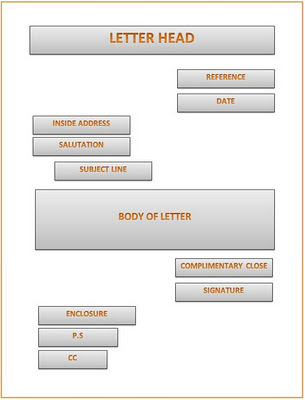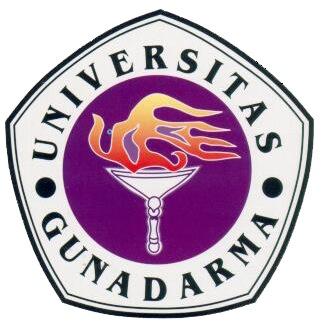STYLE OF BUSINESS LETTERS
- Full Block.
1. Return Address: If your stationery has a letterhead, skip
this. Otherwise, type your name, address and optionally, phone number.
These days, it’s common to also include an email address.
2. Date: Type the date of your letter two to six lines below the
letterhead. Three are standard. If there is no letterhead, type it where
shown.
3. Reference Line: If the recipient specifically requests
information, such as a job reference or invoice number, type it on one
or two lines, immediately below the Date.
4. Special Mailing Notations: Type in all uppercase characters, if appropriate.
5. On-Arrival Notations: Type in all uppercase characters, if appropriate. You might want to include a notation on private correspondence.
6. Inside Address: Type the name and address of the person
and/or company to whom you’re sending the letter, three to eight lines
below the last component you typed. Four lines are standard.
7. Attention Line: Type the name of the person to whom you’re sending the letter.
8. Salutation: Type the recipient’s name here. Type Mr. or Ms. [Last Name] to show respect, but don’t guess spelling or gender.
9. Subject Line: Type the gist of your letter in all uppercase characters, either flush left or centered. Be concise on one line.
10. Body: Type two spaces between sentences. Keep it brief and to the point.
11. Complimentary Close: What you type here depends on the tone and degree of formality.
12. Signature Block: Leave four blank lines after the
Complimentary Close to sign your name. Sign your name exactly as you
type it below your signature. Title is optional depending on relevancy
and degree of formality.
13. Identification Initials: If someone typed the letter for you,
he or she would typically include three of your initials in all
uppercase characters, then two of his or hers in all lowercase
characters.
14. Enclosure Notation: This line tells the reader to look in the envelope for more. Type the singular for only one enclosure, plural for more.
15. CC:
Stands for courtesy copies (formerly carbon copies). List the names of
people to whom you distribute copies, in alphabetical order.
- MODIFIED BLOCK STYLE
- SEMI BLOCK STYLE
Sample Form Letter Semi Block Style :
Description:
1.Kop Letter
2. Date of preparation of letters
3. Letter No.
4. attachment
5. case
6. The letter addressed
7. a word of salutation
8a. Introduction letter
8b. Explanation letter
8c. The cover letter
9. Greetings Closing
10. Name of office
11. signature
12. Names to approach
13. copy
14. Attachment page letter / initials
- INDENTED STYLE
The indented layout of business letters is what people are
most used to because this is how letters were written before PCs which really
has been a long time, come to think of it.
- SIMPLIFIED STYLE
Simplified-style business letters contain all the same
elements as the full-block and semi-block letters. Like the full-block format,
the simplified format left-justifies every line except for the company logo or
letterhead. The date line is either slightly right of center or flush with the
center of the page. Letters written in the simplified format have fewer
internal sections, such as the body, salutation and date line.
Using the simplified style is the most useful at
times when you don’t have a recipient’s contact name. Because the simplified
style does not require a salutation, you don’t need the person’s name. The
simplified format does away with unneeded formality while maintaining a
professional approach.
- Hanging-Indented Style
This very useful style places the first words of each
paragraph prominently on the page. It is useful for letters that deal with a
variety of different topics. However, for normal business communications, this
style is very rarely used. The first line of the paragraph begins at the
left-hand margin. And the other lines of the same paragraph are indented three
to four spaces. This is the reversal of semi-indented style discussed in other
page.
PART OF BUSSINESS LETTERS

1. Letter Head (Letterhead)
An identity that contains the logo, name, address and telephone of the sender of the letter.
2. Reference Line
In an English letter usually containing the letter in front of the name
of the executive who signed the letter, followed by a slash or a colon,
then the name of the letter typer. Some companies add certain codes or
numbers based on their archive system. Reference is placed at the top of
the letter above date.
Example: Your ref: 22 March 2004
Our Ref: BS / KF
3. Date Line (Date)
This is the part of the letter making date. While the writing format for
the date is month / day / year, for example August 30, 2012.
- Example writing date using British Style
3 rd April 1990
British Style writing format is almost the same as writing in
Indonesian, only on the date added by the suffix number. The date
position on the British Style is placed on the right of the letter.
- Example writing date using American Style
April 03, 1990
Writing date using American Style is placed in the upper left of the letter in the format of Month Date, Year.
4. Inside Address
This section contains the name of the receipt of the letter, the office,
and the name of the company accompanied by the address. If you are not
sure who (name) the letter is intended, do not empty it, but try to use
its position, such as "Director of Human Resources". Give the distance
between the date and the recipient.
5. Attention Line
An Alternative to place the recipient of the letter.
6. Solutition
In this section, the term used is "Dear Mr./Mrs./Ms. (last name of
acceptance) ", for example" Dear Mr. Fathoni ". But if the recipient's
name is not acknowledged, write the name of the department, for example
"Dear Director of Department of Human Resources". Give the distance
between the opening greeting and the contents.
For business partners who are familiar with each other, usually write with "Dear Sue"
The use of punctuation marks on salutation using the British Style is
written without punctuation (semicolons or commas) and in American Style
using a colon.
Dear Mr. Krisman => example in British Style
Dear Mr. Krisman: => example in American Style
7. Subject Line (Subject)
Regarding making the recipient of the letter easier to find the purpose
of the letter, such as Invitation, Apology, and so forth. This is an
optional part of the business letter, meaning that we can include it or
not. Writing the subject using British Style: The subject is placed
between salutation and the contents of the letter.
Writing subject using American Style: Subject is placed above salutation.
8. Body Of Letter (Fill in the Letter)
The contents of the letter is a place where you write down what you want
to convey. Paragraph in the contents of the letter must use single
space (single space) and without any separation between each paragraph.
Give the distance between the end of the contents with the cover.
a. Opening
Opening sentences are usually an introduction and often
refer to the previous letter relating to the same problem, serving as an
introduction or introduction to the subject matter to be conveyed. In this
case, references or letter numbers are very important. Usually, the opening
sentence starts with phrases like "thank you for your letter ...",
"together this ...", "with regard to ......".
Here are some examples of opening opera often used.
1) We hereby let you know that ...
2) We hereby declare that ...
3) With this letter we explain that ...
4) With this letter we convey that ...
5) I would like to ask you for help ...
6) We are very sorry to say that ...
7) I am sending this to you ...
8) We send this letter ...
9) Based on a circular letter, we hereby assign ...
10) With regard to ..., we ask you to ...
11) Regarding your letter number ..., I hereby let you know
that ...
12) In order to implement ... we hereby assign ...
13) Reply to your letter dated ...
14) Answering your question about ... with this ...
15) Following our date letter, we hereby inform you that ...
16) In accordance with the letter ... we send it together
...
Because of its function as an introduction, not a few
authors ignore this section. The author goes straight to the contents. Here's
an example:
1) We inform you that
on June 16, 2005, all department heads must conduct a budget meeting.
Therefore,….
2) The Chair of the
Indonesian Language and Literature Education Department, FPBS, Indonesian
Education University, gives the task to ...
3) We announce
that on August 16, 2004, all students must follow ...
b. Message
This paragraph is a place to accommodate the main purposes
of the letter writer. Because of that, it could be the contents of more than
one item if the author's intention consists of two or more. Each content zone
holds one main purpose with the aim that readers can understand it more easily.
Content must be related to the opening paragraph. In other
words, what is stated in this paragraph must be related to the introduction
presented earlier in the opening paragraph. For this reason, the content with
the opening paragraph requires conjunctions such as in connection with the
above, with regard to the above, or relating to it.
c. Closing
Like the opening, closing is often a single sentence. The
closing is used to re-establish the atmosphere of politeness. The closing is
also used to show the actions or steps that the writer wants to do in the
future. The closing generally contains a thank you or expression of
appreciation. Example:
1) Thank you for
your attention.
2) We thank you
for your attendance at our event.
3) We hope that you will be present at the
event.
4) We are happy
if you are pleased to attend on time.
5) Thank you very
much for you orders and we are looking forward to serving you soon.
9. Complimentary Close (Greetings)
This section as a sign that your letter has been completed, usually ends
with the writing "Sincerely", "Sincerely yours", "Thank you", and so
on. Note, There is a comma at the end of the closing and only the first
letter uses capital letters. Give 3-4 lines between the cover and the
name, which will be used for the signature.
10. Signature
This part is the author's signature, usually using black or blue ink.
11. Enclosure (Appendix)
If a letter contains a document or attachment other than the letter, the
author must display the number of attachments by using "Enclosure
(number of attachments)", for example "Enclosure (6)".
12. Carbon Copy Natation.
This section is used to inform the recipient of the letter, that the
letter is also sent to those who need to know the contents of the
letter. CC is placed in the bottom left of the letter.
Example: CC: Finance Section
refrensi:























0 komentar:
Posting Komentar